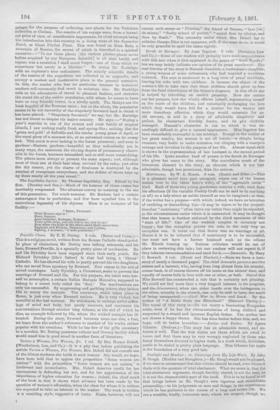The Gardens of the Sun, By F. W. Burbidge. (Murray.)—Mr.
Burbidge, who is connected with the Botanical Gardens of Trinity College, Dublin, visited Borneo and the Islands of the Sulu Arehi- pelage, for the purpose of collecting new plants for the Voitchian collection at Chelsea. The results of his voyage were, from a botani- cal point of view, of considerable importance, its chief triumph being the introduction into this country in a living state of the Nepenthes Rajah, or Giant Pitcher Plant. This was found on Eine, Balu, mountain of Borneo, the ascent of which is described iu a spirited narrative :—" To see these plants [the various pitcher-plants never before acquired by any European botanist] in all their health and vigour, was a sensation I shall never forget,—one of those which we experience but rarely in a lifetime." So writes Mr. Burbidge, with an explorer's true enthusiasm. The strictly scientific details of the results of the expedition are collected in an appendix, and occupy a modest and unobtrusive place in the general narrative. In this, the reader who has no particular interest in botanical matters will commonly find much to entertain him. Mr. Burbidge tells us his adventures of travel in pleasant fashion, and sketches the social life of the native population, with whom ho seems to have been on very friendly terms, in a kindly spirit. The Malays are the least hopeful of the Borman races ; but on the whole, the population seems to bo not unworthy of the singularly favoured land in which it has been placed. " Singularly favoured," we say, but Mr. Burbidge has not learnt to despise his native country. He says :—" During a year's rambles in one of the richest and most fertile of tropical islands, I saw nothing really fresh and spring-like ; nothing like the 'green and gold' of daffodils and the tender young grass of April, or the royal glory of a summer iris, or an autumnal crocus on its mossy bed. This much is ever lacking in the forest primeeval; and even in gardens—Eastern gardens—beautiful as they undoubtedly are in many ways, the sameness, the cloying degree of permanency observ- able in the forest, becomes intensified, and so still more unsatisfying. The plants seem always to present the same aspect ; and, although most of thorn are at their best when revived by the rainy, just after the dry season, yet the charm of freshness is destroyed by the number of evergreens everywhere, and the driblet of bloom kept up by them nearly all the year round."



































 Previous page
Previous page